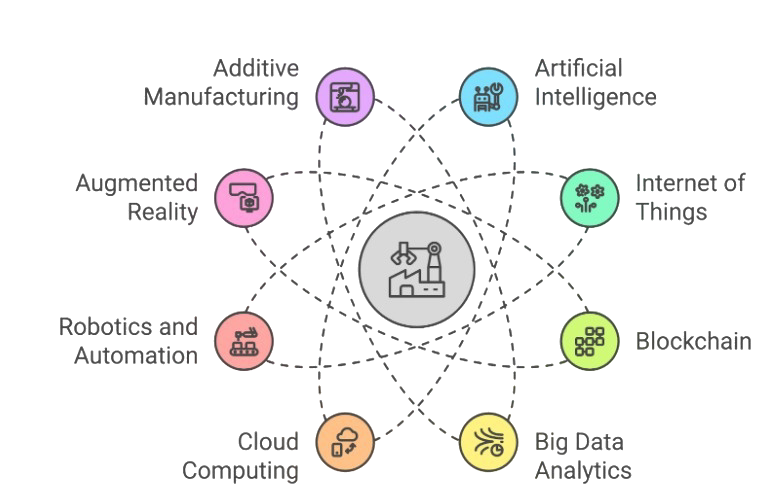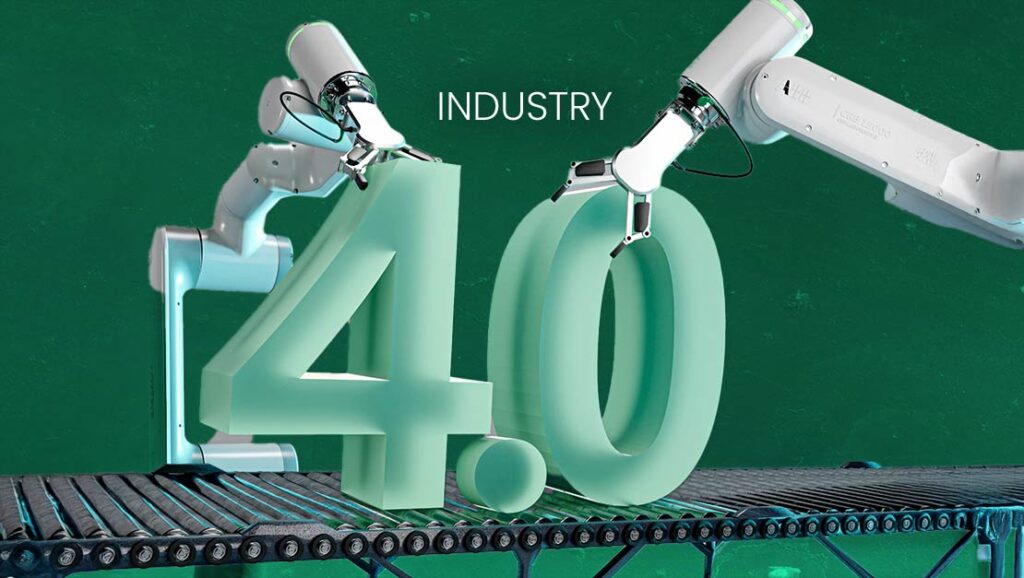Throughout history, we’ve seen critical industries like manufacturing undergo significant change, starting with the first industrial revolution. We’ve come a long way from steam-powered engines, and are now experiencing the fourth industrial revolution, or Industry 4.0, which is influencing how we manufacture and work.
Industry 4.0 is enabling companies to work more productively, focusing on interconnectivity, real-time data analytics, and workflow efficiency. These changes are driven by a number of different technologies that make up Industry 4.0, such as artificial intelligence, blockchain, automation, robotics, and others.
In this piece, we’ll go over Industry 4.0 and its preceding revolutions, the modern technologies driving change, and the benefits and challenges that come with these new applications.
What Is Industry 4.0?
Industry 4.0, also referred to as the fourth industrial revolution, is the next step in the evolution of manufacturing, driven by technologies that allow for automation, data analytics, and human-machine connection.
Several modern technologies are acting as the key force behind Industry 4.0, such as Internet of Things (IoT) devices, artificial intelligence (AI), robotics, machine learning (ML), and others. These systems are making it possible for the manufacturing sector to benefit from more connected operations, moving the industry forward at an incredibly quick pace.
The previous three industrial revolutions were marked by different technologies, each of which was groundbreaking for its time:
- First industrial revolution: The steam engine in the early 1800s paved the way for new manufacturing methods that didn’t rely solely on manual animal and human labor
- Second industrial revolution: With the invention of electricity, manufacturing evolved yet again and new machinery was invented that enabled mass production
- Third industrial revolution: By the mid-20th century and the advent of computers, manufacturing benefitted from new automation and robotic technology
Now, manufacturers are yet again turning to cutting-edge technologies to create smart factories that are boosting productivity and leading to new possibilities.
The Core Industry 4.0 Technologies

While previous industrial revolutions were marked by specific technologies like steam and electricity, it’s more challenging to point to one specific technology in Industry 4.0. Rather, the newest industrial revolution is taking place thanks to a convergence of different highly developed tools that work individually and together to offer manufacturers advanced automation and remarkable productivity enhancements. Here’s a look at the key technologies driving digital transformation in Industry 4.0:
- Artificial intelligence (AI): Helps factories predict when machines need maintenance, improves quality control, and even forecasts demand to keep things running smoothly
- Internet of Things (IoT): Connects machines, sensors, and systems so everything talks to each other in real-time, making factories smarter and more efficient
- Blockchain: Adds security and transparency to supply chains, making it easier to track products, prevent fraud, and share data securely
- Big data analytics: Turns massive amounts of factory data into useful insights to boost efficiency, cut waste, and improve product quality
- Cloud computing: Makes it easy to store, access, and share manufacturing data from anywhere, helping teams collaborate and monitor operations instantly and remotely
- Robotics and automation: Speeds up production, improves precision, and takes care of repetitive tasks so workers can focus on more complex jobs
- Augmented reality (AR): Gives workers real-time digital overlays for training, troubleshooting, and assembly, making their jobs easier and more efficient
- Additive manufacturing/3D printing: Allows for rapid prototyping, custom production, and small-batch manufacturing without the high costs of traditional methods
- Autonomous robots and vehicles: Takes over tasks like moving materials and managing warehouses to cut down on labor costs and improve safety
How Is the Fourth Industrial Revolution Benefitting Manufacturing?
The technologies we covered above are bringing a lot of advantages to the manufacturing sector, paving the way for manufacturing companies to grow in leaps and bounds compared to previous industrial revolutions. According to a study by McKinsey, facilities that have already begun adopting and implementing AI and other new technologies by 2025 can increase cash flow by 122%, while counterparts who fail to adopt these systems risk falling behind. Here’s a look at how Industry 4.0 is making a difference:
Better Safety
With robotics, autonomous vehicles, and other systems handling a lot of the manual work, there are fewer opportunities for safety incidents, making the newest wave of industrial development safer for everyone. Not only that, but the introduction of predictive maintenance makes it easier to prevent incidents and breakdowns that can impact safety.
Improved Efficiency and Productivity
The technologies powering Industry 4.0 are advancing productivity at speeds we’ve never encountered before. With automation, AI, and big data analytics, manufacturers can work more efficiently, relying on these systems for deep insights that inform real-time operations for split-second decision-making and course corrections.
Lower Operational Costs
While some of the startup costs of implementing systems like autonomous robotics, cloud-based technologies, or IoT devices, the long-term benefit is that these systems will lower spending over time. With better compliance, more accurate manufacturing processes, and decreasing reliance on manpower for manual tasks, companies can streamline costs and reallocate budgets more intentionally.
More Collaborative and Integrated Workflows
The technologies driving Industry 4.0 are unique because, by design, they’re meant to work together. For example, AI in manufacturing intersects with automation and robotics, IoT devices facilitate blockchain supply chain management, and so on. This is creating an environment where teams are able to collaborate virtually and share data in real-time across different remote platforms.
Superior Data and Insights
The data gathered from technologies like cloud systems, automation tools, and AI are making it easier for teams to make big decisions based on relevant insights. In previous industrial revolutions, the focus was solely on productivity, but in Industry 4.0, there’s a deeper understanding that productivity is powered by accurate, reliable data and that’s become a core focus.

Industrial Revolution 4.0 Challenges and Considerations
There’s no doubt about the advantages Industry 4.0 technologies are bringing to organizations, but that doesn’t mean it’s without its challenges. To effectively implement new technologies, it’s important to be aware of common roadblocks to avoid complications and delays.
Initial Investment and Maintenance Costs
For some companies, particularly smaller ones, the initial investment and ongoing maintenance fees attached to new technologies can be prohibitive, making it difficult to get a foot in the door. Instead of overhauling all systems in one go, organizations can start implementing technologies incrementally to build smart factories over time.
Workforce Skills Gap
With new technologies come new skills as employees need to learn how to operate modern systems. When workforces become used to operating under a certain framework, reskilling them can be a challenging journey, but with an ongoing training and education strategy and hiring with new technologies in mind, companies can overcome this hurdle.
Cybersecurity Threats and Vulnerabilities
With steam and electricity powering operations, companies didn’t need to worry as much about cyber threats. Now, as systems rely heavily on internet connectivity, it’s critical for manufacturers to manage cybersecurity vulnerabilities to keep production lines safe and running. Adopting cybersecurity standards and limiting access to sensitive data is a great way for companies to mitigate potential risks.
Technological Integration Complexities
Outdated legacy systems can be tough to integrate with more modern applications, which is why it’s so important for companies to assess their tech stack before adopting new systems and involving their IT team closely throughout implementation.
Full Steam Ahead With Industry 4.0
We’re in the midst of the fourth industrial revolution, with new technologies popping up all the time to improve the way we work. Smart factories are no longer a concept of the future, but a current reality for many organizations. With technologies getting stronger all the time, new systems like aiOla’s speech AI are making their way onto the manufacturing floor, integrating with Industry 4.0 systems and making it easier to build interconnected workflows.
aiOla, a speech AI technology, makes it possible for frontline workers and manufacturers to work safer, smarter, and quicker just through the power of speaking. Technologies like aiOla are transforming the manufacturing industry, making it possible for all types of companies to access advanced technologies that don’t require lengthy onboarding processes or steep learning curves.
Book a demo with one of our agents today to learn how aiOla can help improve Industry 4.0 technologies in your company.







